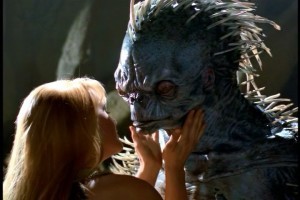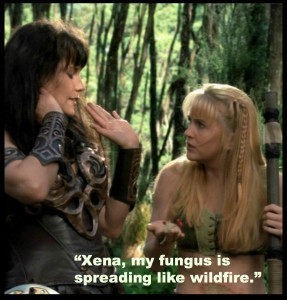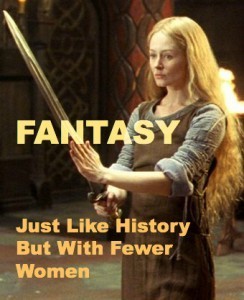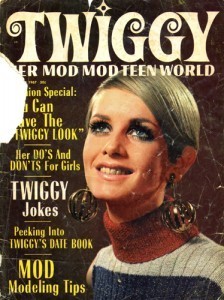Tansy Rayner Roberts's Blog, page 94
December 12, 2012
Gender, Fantasy & Female Pirates
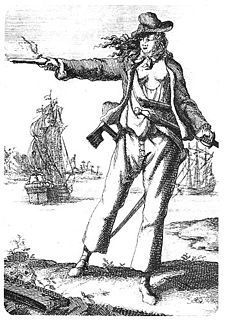 Some great posts doing the round this week, some in response to my Historically Authentic Sexism in Fantasy post, and some being independently awesome but theme-relevant.
Some great posts doing the round this week, some in response to my Historically Authentic Sexism in Fantasy post, and some being independently awesome but theme-relevant.
Foz Meadows follows up on my post with an incredibly impressive horde of links about women in history, in support of the very important point that Your Default Narratives Are Not Apolitical. Writing sexist or male-centric narratives into your stories is a choice, regardless of how much thinking you put into that choice.
Hoyden About Town, meanwhile, called for some recommendations of fantasy novels that treat women like people, and they haven’t had nearly enough of them yet. Go, recommend, and read!
J. Michael Melican talks about his own personal revelations about gender, sexism and fantasy – some thoughtful stuff there, particularly in how to take uncomfortable feedback as a writer that you may not be doing it right yet, despite the best of intentions.
Sean the Blogonaut follows up on one of the points raised in the comments field of my essay over at Tor.com, in which it was stated by a fervent believer that the large majority of SF & Fantasy readers were men – having recently read Helen Merrick’s The Secret Feminist Cabal, Sean has a lot to say about that idea, and how destructive it is for each generation to keep repeating the myths that women liking SF/Fantasy is somehow a new thing, and that OBVIOUSLY things are getting better genderwise in the field without anyone actually having to change their behaviour.
And finally the link passed on most often to me this week is that of Scott Lynch passionately defending middle aged black pirate captain mother-of-two in his latest book from people who think that lady pirates didn’t exist, and it’s somehow a weird and unrealistic political choice to include one in a MAGICAL STORY ABOUT MAGIC.
EDIT: Cheryl Morgan on “Women in Sensible Social Decisions” points out some recommendations for fantasy with great women characters in them which should absolutely be the next stage of this discussion. There’s LOTS of great fantasy out there that recognises that women are people, and that there are as many of them doing stuff and being affected by Epic Things as men.
Teen Movie Times
 If, like me, you really enjoy fun pop culture analysis, please check out Karen Healey’s new ebook: Teen Movie Times for $1.99 on Smashwords.
If, like me, you really enjoy fun pop culture analysis, please check out Karen Healey’s new ebook: Teen Movie Times for $1.99 on Smashwords.
Karen, one of my favourite YA writers (both because of her books and because she is super nice) is putting herself through teacher training college in Christchurch next year so she can become (gulp) a high school teacher. The thought of that scares the pants off me, frankly, but I’m sure Karen is up to the job – and she is trying to raise some funds right now to help towards her (considerable) expenses over the next year.
Check out Karen’s post here about the book itself, a collection of essays about the best teen movies EVER including Clueless, Empire Records, Bring It On, Saved!, But I’m a Cheerleader, etc. (If nothing else, she’s going into her new profession armed with some exceptional meta about the stories of teenagers… and you can too!) The book also includes her essay ‘Romancing the Sro’ which talks about the importance of female friendships in movies, and how little we hear about them compared to their counterpart, the Bromance.
For a taste of what you would be buying you can also check out Karen’s recent essay ‘Easy A’ from the collection on her blog.
Help a Sro Out!
December 10, 2012
The Polly Wright Appreciation Society: Highland Edition [WHO-50—1967]
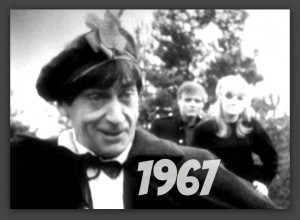 Yes, I’m talking about Ben and Polly again. Mostly Polly. She tends to get put down by modern fans as one of the ‘screamers,’ a mini-skirted avatar representing the show’s sexism, with particular reference to that one time she made tea for everyone in The Moonbase. Anneke Wills herself, the actress who played Polly, insisted that Polly’s passive girlieness was deliberate, in contrast to her gung ho predecessor, Sara Kingdom, and the other great female action hero of the time, Emma Peel (Diana Rigg) of The Avengers.
Yes, I’m talking about Ben and Polly again. Mostly Polly. She tends to get put down by modern fans as one of the ‘screamers,’ a mini-skirted avatar representing the show’s sexism, with particular reference to that one time she made tea for everyone in The Moonbase. Anneke Wills herself, the actress who played Polly, insisted that Polly’s passive girlieness was deliberate, in contrast to her gung ho predecessor, Sara Kingdom, and the other great female action hero of the time, Emma Peel (Diana Rigg) of The Avengers.
Last week I mentioned the recent Big Finish special “The Five Companions,” in which Polly established that she does actually see Ben naked on a regular basis. Also in that story, she gets to address her concerns that she wasn’t much use to the Doctor – making tea, screaming and so on. I had to go a bit hmmm at that because it seemed to me more of a case of the fan perceptions being addressed rather than the character who actually appeared back in the day.
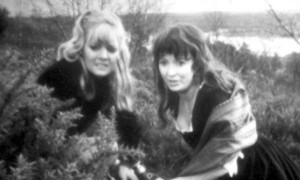 Polly didn’t have to convince me that she was awesome, not in the least. Because, you see, I have read the Target novelisation of The Highlanders. I’ve listened to it, too – the story is one of the many destroyed ones, but it exists in audio form.
Polly didn’t have to convince me that she was awesome, not in the least. Because, you see, I have read the Target novelisation of The Highlanders. I’ve listened to it, too – the story is one of the many destroyed ones, but it exists in audio form.
The Highlanders, like The War Machines, shows that there’s so much more to Polly than that blonde girl who makes tea. When Ben, the Doctor and their new acquaintance Jamie are captured by the opposing army in the middle of the Scottish Highlands, Polly takes off across the moors with her brand new “dour Scotch lassie” BFF Kirsty. She kicks off her shoes and runs barefoot over the turf, taunting and outsmarting the Redcoat commanding officer, bantering left right and centre, and even making the occasional bit of feminist commentary.
Sure, they cheat a tiny bit by making the Highland lass Kirsty so wet and prone to tears that she makes Polly look like Emma Peel and Sara Kingdom put together by comparison, but it’s still two girls romping around historical Inverness and its environs in disguise, getting the better of everyone. Kirsty’s character development as Polly’s influence begins to affect her is just lovely, though she never loses her personality. The scene in which Polly reveals her master plan for them to disguise themselves as orange sellers, and Kirsty’s aghast reaction to that is one of my favourites.
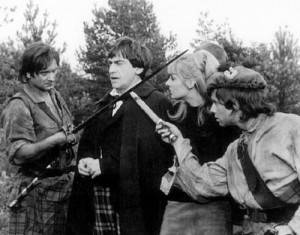 The Highlanders is one of those perfect Doctor Who stories in that there is a narrative showcase for each of the regular characters that suits them very well. Polly gets an adventure, flirtation, banter and the aforementioned BFF. The Doctor gets to dress up in silly costumes (including that of a washerwoman, with shades of Mr Toad) and hats, to put on various accents, and to dabble heavily in politics. In only the second story featuring Patrick Troughton, he is having the time of his life. Ben gets to be brave and rebellious, and most of all gets to be a sailor – his more interesting scenes are on the boat where captured Scottish rebels are being manipulated into signing contracts to become plantation workers, and Ben not only acts as the voice of snark undercutting the whole enterprise but gets a cliffhanger to himself when he is hog-tied and chucked overboard. (He also later gets a chance to brag about how clever he was in pulling the old Houdini trick) Even Jamie, quite subdued in this first story, though his character is already fully realised, gets plenty of opportunity for brash heroism and loyal friendship.
The Highlanders is one of those perfect Doctor Who stories in that there is a narrative showcase for each of the regular characters that suits them very well. Polly gets an adventure, flirtation, banter and the aforementioned BFF. The Doctor gets to dress up in silly costumes (including that of a washerwoman, with shades of Mr Toad) and hats, to put on various accents, and to dabble heavily in politics. In only the second story featuring Patrick Troughton, he is having the time of his life. Ben gets to be brave and rebellious, and most of all gets to be a sailor – his more interesting scenes are on the boat where captured Scottish rebels are being manipulated into signing contracts to become plantation workers, and Ben not only acts as the voice of snark undercutting the whole enterprise but gets a cliffhanger to himself when he is hog-tied and chucked overboard. (He also later gets a chance to brag about how clever he was in pulling the old Houdini trick) Even Jamie, quite subdued in this first story, though his character is already fully realised, gets plenty of opportunity for brash heroism and loyal friendship.
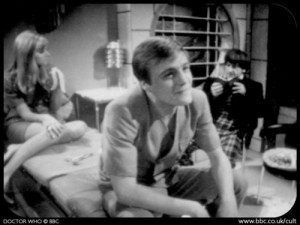 It’s the team of Ben, Polly and the Doctor that really shines here – they spend much of their time apart but come together every now and then to confer and reassess the situation. I enjoy the various partings and reunions, and especially the fact that both Ben and Polly have become quite immune to the quirks of this new Doctor already. Polly is amused by his cros-sdressing, and Ben doesn’t turn a hair when the Doctor suddenly appears to betray him in order to get himself released from prison – obviously he has a sneaky plan.
It’s the team of Ben, Polly and the Doctor that really shines here – they spend much of their time apart but come together every now and then to confer and reassess the situation. I enjoy the various partings and reunions, and especially the fact that both Ben and Polly have become quite immune to the quirks of this new Doctor already. Polly is amused by his cros-sdressing, and Ben doesn’t turn a hair when the Doctor suddenly appears to betray him in order to get himself released from prison – obviously he has a sneaky plan.
Another fantastic bit is when the Doctor, Ben and Polly are finally all in one place and putting together their final plan to smuggle weapons to the prisoners on the ship – the men have taken charge of the situation, leaving Polly and Kirsty out of it. Not only Polly but also Kirsty speaks up, demanding that they get a role in the plan given all their hard work thus far. The Doctor reconsiders, and includes them.
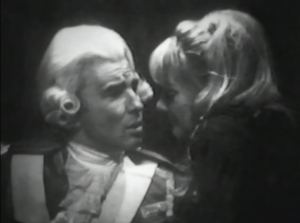 Right at the end, it’s not amateur dramatics or manly heroics that saves the day. It’s a combination of chivalry and Stockholm syndrome! Polly has been tormenting poor old Algernon Ffinch for the whole four episodes, threatening to let his fellow officers know he was kidnapped by two girls, and after flirting, robbing, blackmailing and making the poor young gentleman’s life a misery for the last several days, he sides with her against the villain and justice is done.
Right at the end, it’s not amateur dramatics or manly heroics that saves the day. It’s a combination of chivalry and Stockholm syndrome! Polly has been tormenting poor old Algernon Ffinch for the whole four episodes, threatening to let his fellow officers know he was kidnapped by two girls, and after flirting, robbing, blackmailing and making the poor young gentleman’s life a misery for the last several days, he sides with her against the villain and justice is done.
Jamie is awesome, and I think that his companion-Doctor relationship with Two is one of the great and iconic friendships of the series’ long history. But part of me kind of wishes that Kirsty had hopped aboard the TARDIS at the end of this story. She and Polly would have ruled the space ways together!
ELSEWHERE ON 1967:
Marlow, Inc is producing some gorgeous illustrations of the Doctors and companions in chronological order: Two, Ben, Polly, Jamie, Victoria [Marlow, Inc]
The Mystery of the Cosmic Hobo, or: Bow Ties Are Cool [Tor.com]
The Underwater Menace [Wife in Space]
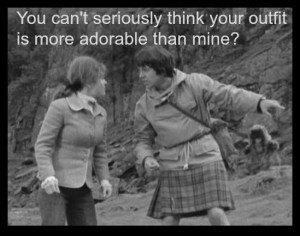 60′s Companion Anneke Wills (Polly) talks about the return of a lost episode of The Underwater Menace [SFX]
60′s Companion Anneke Wills (Polly) talks about the return of a lost episode of The Underwater Menace [SFX]
The Faceless Ones [Wife in Space]
My Three Year Old Daughter Jem Reviews Lost Episodes of Evil of the Daleks and The Abominable Snowmen [Tansy on Tumblr]
Victoria Waterfield and Tomb of the Cybermen [Calapine on LJ]
The Abominable Snowmen [The Memory Cheats]
December 8, 2012
A Year in TansyRR.com
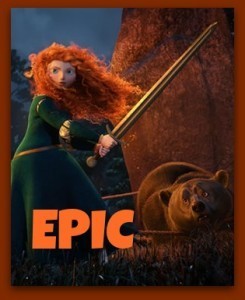 The response to my Tor.com post on “Historically Authentic Sexism in Fantasy” has been pretty overwhelming. Not only have there been many, many readers over there (the comments thread is still going strong, though it has turned overnight into a discussion about gender in children’s fiction which… is not a bad thing to be talking about?) but over 2500 people have tuned in to this blog to check the post out here, since Thursday. That’s… a lot, by my standards.
The response to my Tor.com post on “Historically Authentic Sexism in Fantasy” has been pretty overwhelming. Not only have there been many, many readers over there (the comments thread is still going strong, though it has turned overnight into a discussion about gender in children’s fiction which… is not a bad thing to be talking about?) but over 2500 people have tuned in to this blog to check the post out here, since Thursday. That’s… a lot, by my standards.
So if you’re here for the first time, hi, I’m Tansy! I write books, and talk a lot.
Here are some other Gender & Pop Culture posts from this year that I’m quite proud of:
Sexing Up the Classics
Mothers & Daughters, Battle-Embroidery & Bears
Babies & Bicycles: Watching Call the Midwife
Hack, Slash, Squish: Gender and Sex In Season One of Game of Thrones
What Geek Girls Wear (is none of your business)
Pratchett’s Women VII: A Wonderful Personality and Good Hair
Pratchett’s Women VIII: Has Scythe, Will Teach School
Pratchett’s Women IX: The Truth Has Got Her Boots On
Where the Wonder Women Are (30 posts on female superheroes and counting)
There’s also the Matrons of Awesome series from last year which addresses some of the ‘women were interesting in history, despite sexism’ issues from my article.
You can also find my essay on the Sixth Doctor and Trial of a Time Lord, The Ultimate Sixth, in the recently released book of essays Chicks Unravel Time.
And if all that reading is too much, I would be remiss in not mentioning Galactic Suburbia, the feminist SF & publishing podcast that I do with Alisa and Random Alex. So much crunchy goodness.
December 7, 2012
My Fungus is Spreading [Xena Rewatch 4.1-4.4]
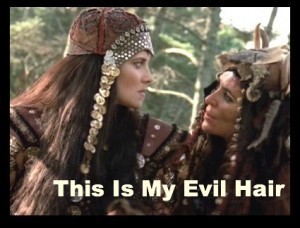 4.1 Adventures in the Sin Trade Part 1
4.1 Adventures in the Sin Trade Part 1
Ahh, those same old opening credits from Season 1, becoming less and less relevant.
Season 4 is the one I liked least of the entire Xena run, but given how long it took me to make my way through Season 3, previously my favourite, I am hoping to have my preconceptions challenged a little!
This episode is off to a good start, with an angry Xena chasing down the distracted and overworked god of the Underworld, Hades, across a battlefield which looks remarkably vivid for a single scene. The visuals of this season certainly have kicked it up a notch!
When she realises that Gabrielle’s dead spirit has almost certainly been filed with the Amazons, Xena ditches her beloved horse Argo and rides off across the Steppes (their ancestral land, apparently), burying her grief in a series of flashbacks about the last time she had anything to do with the Amazon afterlife…
Cue a long and complex saga involving Bad Hair Xena’s past affair with the dangerous but squishy-centred warlord Borias (long dead father of her now equally dead son Solan) and her encounter with the sinister shaman Alti.
One of the best things about the dynamic and ever-expanding backstory of Xena as a character is the tradition of powerful, mostly female role models she met along the way, mostly women who were far too good and noble for her to appreciate them as much in her Bad Hair days as Good Hair Xena did later, retrospectively. It’s like she stored her education in her head for when she was old enough to appreciate it. Though I suppose technically that’s how most education works…
Lao Ma, M’Lila… yeah Alti’s not one of those inspiring women. She’s very much the crazy-ass evil role model that Bad Hair Xena actually wanted, rather than a woman who would be retrospectively “good” for her once she started seeing straight..
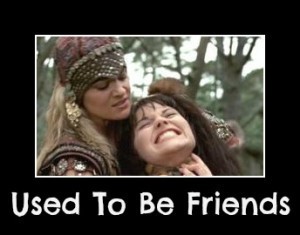 After sacrificing a horse (not Argo!) to transport herself to the bleak Amazon land of the dead, Xena of the Now (I hesitate to say Good Hair cos, grieving. Oh hair, you confuse me) crosses paths with Cyane, a ghost from her past who totally makes her collection of ‘ladies I would have been BFF’s with had I met them when I was nicer,’ and whom I took valuable lessons from once they were dead.”
After sacrificing a horse (not Argo!) to transport herself to the bleak Amazon land of the dead, Xena of the Now (I hesitate to say Good Hair cos, grieving. Oh hair, you confuse me) crosses paths with Cyane, a ghost from her past who totally makes her collection of ‘ladies I would have been BFF’s with had I met them when I was nicer,’ and whom I took valuable lessons from once they were dead.”
Gabrielle is nowhere in sight, but this new quest to redeem the sins of Xena’s past by helping Cyane and her Amazons to pass through the gate to eternity becomes a welcome distraction from that.
On a personal note, this season marks the point that I discovered online fandom, and thus my experience of these Xena episodes was assisted greatly by such resources as the old Whoosh! Episode Guides, fanfic and so on. 1999 was a big year for me! At the same time I was discovering online fandom for Buffy, my other big show of the time.
In the case of Xena, online resources were essential because of the erratic showings of episodes in Australia, so that I often missed episodes or got to watch them in a fun and apparently random order. Luckily I had been raised in Doctor Who fandom, so was able to navigate these choppy waters with a certain degree of calm and cool.
Oh, and I learned the hard way that reading episode transcripts is not a substitute for the real thing.
Back to Adventures in the Sin Trade. It’s a gorgeous, deeply emotional piece that looks amazing, particularly the new costume designs and the miracle of making New Zealand look like yet another new country and culture. And yet… it does feel very indulgent and slow in places. I miss my Xena banter to balance out the angst. It’s an oddly humourless piece, except for a few odd touches with Bad Hair Xena and Borias, who are the most adorable fucked up couple who never ever should have been together ever.
Oh and by the way? Alti’s spirit is still around, hidden inside an evil horse. That’s the cliffhanger.
4.2 Adventures in the Sin Trade Part 2
The relationship between Borias and Xena – and the key point that he is more into her and love generally than she is into him – is front and center throughout these stories. And yet… really, both episodes are all about the women, not about the hunky barbarian warlord. Sorry, Borias!
But the first big moment of this episode is that Current Xena pins her fringe back out of the way, and takes a steamy bath with one of her new friends. Meanwhile in flashbacks, we get to know more about her complex relationship with the Amazon Queen Cyane, including one of my favourite fight sequences ever in which Bad Hair Xena surprises a topless Cyane in her hut, and Cyane starts out apparently vulnerable, shielding her breasts with her hands, then manages to use her mighty fighting skills to effectively strip Xena of her own armour, dressing herself in those clothes and leaving Xena in little more than a scruffy blanket.
Okay, you kind of had to be there. But it is a hilarious, clever sequence that is more about character development than flashes of nudity, and shows some of the dark humour that I was missing in Part 1. Cyane is a great character, and you can see how she has also retrospectively had some serious influence on Xena’s growth – such as her chilly stare and her battlesmirk.
Interesting that after having her arse handed to her by the blonde Amazon Queen, Bad Hair Xena’s first response is not to declare war on her, but to decide she’s going to have to hang out with her for a while to learn some of her fighting tricks. That’s character progress for you! Lao Ma would be so proud.
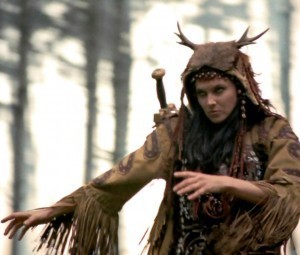 In other news, there are so many strong and interesting women in this story that I have lost track of who some of them are. As soon as they take their reindeer hats off and hop into the sauna, they could be anyone!
In other news, there are so many strong and interesting women in this story that I have lost track of who some of them are. As soon as they take their reindeer hats off and hop into the sauna, they could be anyone!
The reindeer hats are pretty fetching, though.
Ultimately while the whole thing looks gorgeous, there are so many long meaningful looks and fight scenes that I did rather vague out. It doesn’t help that I can’t always figure out which bits are in the past or the present, as it can be one big blur of spiked trees, screaming and leather fringe. But most of all, Alti is no Callisto – she takes herself incredibly seriously, so wrapped up in being the Evil Priestess that she never feels like a real person.
This does not bode well for a future of Xena: Warrior Princess without Gabrielle.
But then, oh. Right at the end, as Xena and Alti fight on the spiritual plane, Alti tries to destroy Xena’s confidence by showing her a dreadful vision of the future: of Xena in a snowy land, being tied to a crucifix by grim-faced Romans. And at her side, an older Gabrielle with short hair, likewise being executed.
That’s what gives Xena the strength to win her fight, because if she and Gabrielle are being crucified in their future, that means Gabs is not dead NOW.
And that, my friends, is a happy ending, Xena-style.
We just have to hope Argo never figures out what she did to that other horse.
Hey, so you know how Gabrielle sacrificed herself to destroy Hope and save Xena, at the end of last season, and it was totally awesome? Well, we’d better hope that that amazing and powerful finale is not wrecked in any way, by rendering both deaths as being massive cheats.
Yes, we’re back in the actual continuity, after Xena’s extended red herring holiday on the Barbarian Steppes. She finds Joxer right where she left him, glumly keeping up a regular supply of fresh flowers on the spot where Gabrielle fell, and tells him of her vision.
Humouring her, he follows her across country to Potidaea, Gabrielle’s home village where they find… well, Gabrielle. Shopping. Happy as anything. Their reunion is swift and joyous, and Gabby explains how she was knocked into a ‘niche in the wall’ while Hope fell to her death.
Yep, it all sounds too easy, doesn’t it?
Bodies are turning up drained of blood in Gabrielle’s previously peace-ridden village. Something is terribly wrong here. It doesn’t help that Gabby’s parents continue to be (understandably) anti-Xena, while embracing Joxer as the potential son-in-law they never knew they wanted.
Cue the schlock horror, and the slow gothic reveal.
Someone is trying to kill me and I think it’s my Gabrielle!
Yes, you guessed it. That whole thing where Gabby and Hope look identical has become mightily inconvenient. Who knew? Once the reveal is made that the Potidaea Gabrielle is in fact Hope, suddenly her acting skills (Hope’s, not Renee’s) fall by the wayside to make it Really Obvious in every scene. Funny how that always happens.
This starts out as a dreadful, dreadful story, which dilutes the brilliant ending from Sacrifice, makes Hope a far lesser villain than ever before, and pretty much chucks away the question of what was going to come of Hope’s Olympian baby to Ares: The Destroyer, Dahak’s grandchild.
Surprise, it’s a carnivorous monster. Pretty much the least interesting option. (what, no one else was looking forward to a ginger-blond Kevin Smith stalking around murdering people and taunting his grandmother Gabrielle?)
However, the story does the necessary job of bringing the real Gabrielle back to Xena – eventually. And the genuine, harder-won reunion is more powerful after our eyerolling was all used up on the insipid fakeout version of that reunion, so there’s that. Once Gabrielle is back in the story, it gets genuinely more interesting, with her having to deal the way her doppelganger daughter has replaced her in her own family.
Ultimately – well, how was this whole messy family saga going to end if not in tragedy? Hope, still angry at Gabrielle for constantly trying to murder her (fair point, really), is ultimately impaled on the spikes of her own monstrous son, himself lashing out at a perceived betrayal, and they die in each other’s arms.
There we have it, one last hideous trauma cherry on top of Gabrielle’s angst trifle. Suddenly following in Xena’s footsteps no longer seems like the way forward for her. But what else is there?
Ah well, she has the whole season to work it out, I’m that won’t have any tedious or annoying aspects to it at all. Oh, Season Four. I was so hoping you had changed in my absence.
So you know how Xena has always had this odd dichotomy of angst-drama episodes, action episodes, and comedy episodes, always treading a fine line between conflicting tones? And how sometimes, the sudden shift of moods of episodes seemed pretty odd and disjointed?
Well, welcome to Season Four, and the beginning of the Sheer Stupid Comedy episodes. It’s truly hard to imagine that this story exists in the same universe as Adventures in the Sin Trade or A Family Affair. The comedy is played so hard for laughs and gross-out moments that it feels painful, especially when Xena gets in on the action – in the past, she’s usually been the straight woman of comedy episodes, except when disguised as someone else. But here she is lice-ridden and slapstick driven, and it’s WEIRD.
Also, her hair is messy, which is screwing with my head. This is NOW Xena, she needs to have shiny hair.
And then there’s the rabbit. The one which is literally straight out of Monty Python. I think you know what kind of rabbit I’m talking about.
Unsubtle and sad, because I loved Xena comedy episodes, and they’ve kind of wrecked them now by taking it to ridiculous extremes. Scabrielle and X-ma. Sigh.
The only positive to come out of this episode is that Gabrielle and Xena are both such disgusting wrecks, and Joxer so patient and competent in dealing with their selfish butts that frankly he can be as annoying as he wants to be for about half a season – he’s earned a LOT of brownie points.
 Oh and it wouldn’t be a real over-indulgent Xena comedy episode without a scene where Xena and Gabrielle bathe together! In this case, with all body mud packs and lice combing. Then swapping at half time.
Oh and it wouldn’t be a real over-indulgent Xena comedy episode without a scene where Xena and Gabrielle bathe together! In this case, with all body mud packs and lice combing. Then swapping at half time.
The whole thing is pretty horrid, and I struggled to get to the end of it. The only thread that kept me going was Xena’s ongoing quest to earn back the love and respect of Argo, who was understandably miffed at being dumped a few episodes before. But even this was handled mostly with great awkwardness.
Then right at the end, Xena and Gabrielle shame Joxer out of taking financial reward for saving the village, so no one even gets to earn a living out of this one.
This episode got stupid all over me.
CHAKRAM STATISTICS:
People who want romance with Xena: 13
People Xena allows to romance her: 7
Xena dead lovers: 3
Gabrielle dead boyfriends: 2/7
“Adorable” children: 36
Babies: 5
Babies tossed humorously in the air during fight scenes: 6
Xena doppelgangers: 4
Xena sings a mourning song: 5
Gabrielle sprained ankles: 2
Xena dies: 3
Gabrielle dies: 4
Characters brought back from the dead (incl. ghosts and visits to the Underworld): 50 [an army of Amazons in this one, pushed the tally up like whoa]
Ares loses his powers and goes all to pieces about it: 2
Xena or Gabrielle earns money: 2
Xena or Gabrielle spends money (or claims to have money to spend): 7
Out of the Pantheon: Morpheus, Ares, Hera, the Titans, Hades, Celesta, Charon, the Fates, Bacchus, Aphrodite, Cupid, Poseidon, the Furies, Discord
The Celebrity Red Carpet of the Ancient World: Pandora, Prometheus, Hercules, Iolaus, Sisyphus, Helen of Troy, Paris, Deiphobus, Menelaus, Euripides, Homer, Autolycus, Meleager, Oracle of Delphi, David, Goliath, Orpheus, Julius Caesar, Brutus, Ulysses, Penelope, Cecrops, Boadicea, Cleopatra, Crassus, Pompey
Previous Xena Rewatch Posts:
Warlord is a Lady Tonight
I Don’t Work For Money
Amazon Wanna Take A Ride?
Go To Tartarus!
Swashbuckle and Shams
Death In A Chainmail Bikini
Full Moon It Must Be Xena
How Do You Mortals Get From Day to Day?
The Future is Archaeologists
Divide and Conquer
My Sword is Always Ready to Pleasure You
Hide the Hestian Virgins!
Lunatic with Lethal Combat Skills
Coping with Your First Kill
Sweet Hestia, I’m In a Den of Filth
The Bitter and Sweet of It
Because Caesar Was Taken
Armageddon When??
Rolling Around Like Weasels
You Killed Me?
December 6, 2012
The Friday Links Initiative
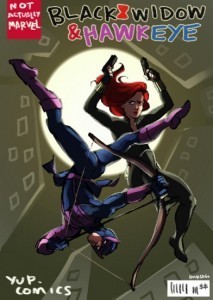 It’s a bit of a strange day so far! Late yesterday morning, I was inspired to rant about Historically Authentic Sexism in Fantasy, Let’s Unpack That instead of what I should have been doing (laundry sorting and packaging Deepings Dolls to post out for Christmas orders). I started to suspect I had something special when the Twitter RT’s went crazy, plus a bunch of traffic from Tumblr thanks to Gwenda Bond, and over 300 people had looked at the post in the first couple of hours. Kate Elliott and Charles Tan both encouraged me to pitch to one of the larger SF Fantasy blogging sites to see if they wanted to mirror the post, to give it more exposure.
It’s a bit of a strange day so far! Late yesterday morning, I was inspired to rant about Historically Authentic Sexism in Fantasy, Let’s Unpack That instead of what I should have been doing (laundry sorting and packaging Deepings Dolls to post out for Christmas orders). I started to suspect I had something special when the Twitter RT’s went crazy, plus a bunch of traffic from Tumblr thanks to Gwenda Bond, and over 300 people had looked at the post in the first couple of hours. Kate Elliott and Charles Tan both encouraged me to pitch to one of the larger SF Fantasy blogging sites to see if they wanted to mirror the post, to give it more exposure.
And, um. So now it’s less than 24 hours since I wrote the thing, over 1200 people have looked at it on my blog alone, and now Historically Authentic Sexism in Fantasy, Let’s Unpack That is up on Tor.com receiving who knows how many more readers, and acquiring a great collection of thoughtful and sincere comments. Publishing, how did I not notice how much FASTER you are these days?
But enough about me, let’s talk about Hawkeye’s butt. I spend a bit of time on Tumblr, but it’s still usually The Mary Sue who alerts me to the biggest events and memes happening over there. This week, it’s The Hawkeye Initiative, based on the essential premise that women are drawn more stupidly than men in comics, in the name of “sexiness.” And as soon as you redraw particular poses so that a man is doing them, the WTFery of all this becomes obvious. Basically it’s the same thing that Jim C Hines is doing with his poses (currently for charity, which is awesome), but without the necessity for a chiropractor.
I love genderbending art, especially when it’s used to make a political point – and genderbending art is at its heart political. Sometimes a picture can make an idea (which should be a no-brainer) more intense and acceptable than any length of essay. And of course, it’s subversive protest by comics fans, another thing that I love. (Even the discomfort that some men are feeling on this use of Hawkeye to illustrate the ongoing discomfort of female comics readers is addressed through art) The comments about the effect of the Initiative on the Tumblr are also interesting to read through.
Speaking of butts, check out The Feminist But, a Kickstarter comic addressing the idea of what ‘spinster’ means today, courtesy of Bitch Magazine.
Bitch has also been running a series of posts on ‘daddy issues’ in pop culture, all of which are worth reading. I can’t resist linking to the one about Murphy Brown and the attitude to single mothers, though. MUST ALWAYS REBLOG MURPHY BROWN.
It’s nearly the end of 2012 and time to look back on the AWW challenge (Australian Women Writers – a challenge for readers and reviewers) – check out the poll if you can, especially if you’re male. Sean the Blogonaut also gives his personal response to the challenge, encouraging more men to take part next year.
Tor looks at a recent Twitter meme about sexism and discrimination in the game design industry: #1reasonwhy
My honey put me on to this webcomic The Oatmeal, which apparently everyone knew about but me? The comic I linked to is specifically about the life of a freelance creative person, which rang far too many bells for me. Painfully identifiable, but very cleverly done!
I’ve been following the i09 ‘Fan Fiction Friday’ with mixed feelings and great interest, and noted today that they have announced they are pulling the column. I can see why. The posts were hilarious and very well expressed – I couldn’t take my eyes off them! But I did have running in my head the question of how it would actually feel as a writer to have your work taken apart so brutally in a public forum. There’s also the point that media exposure is generally seen as a stressful thing for fanfic writers even if it’s positive – I remember the discussion when an mpreg was shortlisted for the Tiptree. Good on i09 for making the tough call, and I hope the writer of the column has other opportunities with them, because he made me laugh my head off even as I squirmed.
And in closing, Fourth Doctor Tea! How can you not want a cup of that? I was a little sad when my hunt for the other Doctors came up empty, though. I fancy a mug of Pertwee right now, and not just because it would probably be spiked with brandy.
December 5, 2012
Historically Authentic Sexism in Fantasy. Let’s Unpack That.
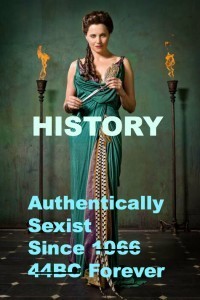 A great, thoughtful article at the Mary Sue on one of my pet topics: the common justification of sexist fantasy fiction being that it’s historically authentic.
A great, thoughtful article at the Mary Sue on one of my pet topics: the common justification of sexist fantasy fiction being that it’s historically authentic.
I am BUSY today, far too busy for a rant, but then I felt one coming on, and was worried I might end up with a migraine if I tried to stifle it. You know how it is. So let’s talk about sexism in history vs. sexism in fantasy.
WARNING, ACADEMIC IN THE HOUSE.
I agree with pretty much everything said in the Mary Sue article: when you’re writing fantasy inspired by history, you don’t have to take all the ingrained sexism of historical societies along for the party, and even when you do, you don’t have to write women in a sexist or demeaning way. Your fantasy will not break by treating women as if they are people too.
But my rant is actually not quite about that stuff at all. It’s about history, and this notion that History Is Authentically Sexist. Yes, it is. Sure it is. We all know that. But what do you mean when you say “history?”
History is not a long series of centuries in which men did all the interesting/important things and women stayed home and twiddled their thumbs in between pushing out babies, making soup and dying in childbirth.
History is actually a long series of centuries of men writing down what they thought was important and interesting, and FORGETTING TO WRITE ABOUT WOMEN. It’s also a long series of centuries of women’s work and women’s writing being actively denigrated by men. Writings were destroyed, contributions were downplayed, and women were actively oppressed against, absolutely.
But the forgetting part is vitally important. Most historians and other writers of what we now consider “primary sources” simply didn’t think about women and their contribution to society. They took it for granted, except when that contribution or its lack directly affected men.
This does not in any way mean that the female contribution to society was in fact less interesting or important, or complicated, simply that history – the process of writing down and preserving of the facts, not the facts/events themselves – was looking the other way.
In history, from primary sources through most of the 20th century (I will absolve our current century-in-progress out of kindness but let’s not kid ourselves here), the assumption has always been that men’s actions are more politically and historically significant to society, BECAUSE THEY ARE PERFORMED BY MEN.
Here’s an example from my honours days: most of the history books looking at Roman state religion were clear that women’s participation in the religious rituals of the state was probably less important or politically relevant, because women were excluded from making blood sacrifice. This was used as evidence, in fact, that women weren’t that important to politics in general. However, more modern and forward-thinking scholars pointed out that in fact the only reason why we assume blood sacrifice was an essential and a more politically important religious rite was because it was restricted to men. Plenty of rituals were restricted to women too, and those rituals were assumed to be less politically relevant on the whole. Guess why. Go on, guess. As it turns out, women did perform sacrifices (mostly of baked goods), and many of their rituals were private rather than public, but they were all performing religous rituals which were essential to the state. Different does not mean better.
Rome was a highly superstitious society which relied on all manner of rituals to feel safe and protected. Those rituals which were performed within the home were as important as those performed in public places – but they weren’t written about to the same extent because they were mostly done by women, often exclusively by women, and secrecy was a common element. There are many reasons why men didn’t write down the details (except when they interacted with court cases) and one of those reasons was, they didn’t know what those details were. Women’s history, sadly, was not much of a thing, and what words women did write down were not preserved over the next millennium.
Guess why. Go on, guess.
Women’s lives were not written down except on the rare occasions that they were useful tools in the politics of men, or where maligning/celebrating them was relevant to the politics of men, bu that doesn’t mean they weren’t really, really interesting by modern standards.
History is not society. It only covers one aspect. History is imperfect, and biased, and it always, always has omissions. The most common omissions are the bits that the writer of that history took for granted that his readers would know.
So how does this affect fantasy fiction?
We have a tendency in fantasy fiction to assume that the military/warfare and the politics (two key elements of epic fantasy, with magic being a strong third) are male domains because this was usually the case in history.
Well, I will agree for the MOST part on the warfare aspect, but I think Battlestar Galactica showed us that you can have female characters on the front lines of your story and still tell very close to the same kinds of stories as you would have done if the soldiers were all men. The Starship Troopers movie, adapting a much earlier work, showed this too. OK those are science fiction, but fantasy does not have to be hamstrung by the social conventions of the past. If you want those social conventions in place for other story reasons then you can get around that too by bringing women into the story. Terry Pratchett’s Monstrous Regiment has a lot to say about the different kinds of women you might find on a battlefield, and the many different reasons why they might be there despite restrictive social mores. Or, you know, you could read some actual history, because for all its patriarchal leanings, you will find that women’s roles in war were a lot more varied than many people expect.
When it comes to politics, I’m sorry, but there are no excuses. Sure, women have been excluded from the public political process for large swathes of history and culture (except, you know, when they weren’t – even the supreme patriarchy that was Rome didn’t have complete control over the provinces, where female politicians and civil servants sprung up like weeds) but public is only one piece of politics. The Mary Sue article refers substantially to Game of Thrones, and that’s a very good example, but again you can look to history – as soon as there is any form of dynastic element to your politics, then women are IMPORTANT. Even when the political careers are solely male, those men have wives and families who have a stake in the proceedings and the outcomes, they have risks to take and campaigns to wage every bit as much as the men. And if the women’s politics are happening in salons rather than assembly halls… maybe you should be peeking into those salons. I can guarantee political DYNAMITE is going on in there. With finger sandwiches and mint tea? Why not?
And you know, if your political system is inherently and essentially misogynist and that is essential to your worldbuilding, then throwing a few women into that system to see what cracks first is actually the most interesting thing you could do. Like with science fiction where SCIENCE GOES WRONG is the most interesting plot.
Then there’s magic. There are no excuses here. None at all. Either you have a magic system which is inclusive of women, or exclusive of women, and in both instances, FEMALE CHARACTERS ARE GOING TO HAVE OPINIONS ABOUT THAT. If you really want a patriarchal, masculine magical system, then as with politics, the most interesting thing you can do is throw women at that system, to see where the cracks are.
So what are the take home messages here?
1. History is more interesting than most people think. Despite everything I have said, it also has quite a lot of women in it. Read some history. Read some more. Check out the social historians, because they’re the ones who tend to pay more attention to what everyone in a society are doing, not just the aristocratic men who think they’re in charge.
2. Treating female characters as people will make your fantasy more interesting. Not just to female readers. To readers who are people. And, let’s face it, most readers are.
3. Make your books better.
Where the Wonder Women Are: #30 Maya
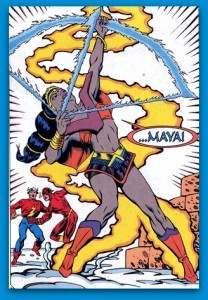 This teen super heroine stems from the period (1993-94) when Justice League Europe transitioned into the second incarnation of Justice League International, and made a serious attempt to be actually globally representative with the team, rather than filling it with mostly Americans and a couple of token “exotic” members. The JLE moved from their Paris Embassy to a haunted castle somewhere in London (handy for the shops) and while they lost the management of the competent Catherine Cobert, Sue Dibny made a very good replacement. Sue had joined the JLE as the wife of Elongated Man, and soon took over the computer and communications systems as her regular job, freeing the others up to actually fight crime.
This teen super heroine stems from the period (1993-94) when Justice League Europe transitioned into the second incarnation of Justice League International, and made a serious attempt to be actually globally representative with the team, rather than filling it with mostly Americans and a couple of token “exotic” members. The JLE moved from their Paris Embassy to a haunted castle somewhere in London (handy for the shops) and while they lost the management of the competent Catherine Cobert, Sue Dibny made a very good replacement. Sue had joined the JLE as the wife of Elongated Man, and soon took over the computer and communications systems as her regular job, freeing the others up to actually fight crime.
The new JLE/JLI that set up home in England included Aquaman of Atlantis, Power Girl of Ancient Atlantis (this was the period when they were pretending she wasn’t Superman’s cousin), Crimson Fox of Paris, Tasmanian Devil of Australia, Dr Light of Japan, and occasionally even included British superhero Lionheart. And of course a handful of American male superheroes too (wouldn’t be a superhero book without them): Elongated Man, the Flash and Metamorpho.
The team also acquired a teenage runaway from India, Chandi Gupta. This frightened thirteen-year-old found her way to the JLE castle in the hopes they could help her deal with the water and fire powers that had come upon her with the onset of puberty. Chandi, who took the name Maya for superhero purposes, could transform into an older and more controlled version of herself, whose weapon of choice was to form a bow and arrow from either mystical water or mystical flame.
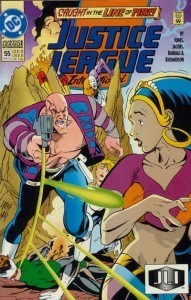 Maya acquired a sprawling and chaotic substitute family in the Justice League, becoming particularly close to Dr Light, Elongated Man and Tasmanian Devil. She also had something of a kid sister relationship with Wally West’s Flash. But she was still haunted by what she had run away from, and eventually (to be honest not that much later, her whole arc was done within less than two years) this was revealed when a JLI conference brought her to Bombay, and she was kidnapped.
Maya acquired a sprawling and chaotic substitute family in the Justice League, becoming particularly close to Dr Light, Elongated Man and Tasmanian Devil. She also had something of a kid sister relationship with Wally West’s Flash. But she was still haunted by what she had run away from, and eventually (to be honest not that much later, her whole arc was done within less than two years) this was revealed when a JLI conference brought her to Bombay, and she was kidnapped.
When Dr Light and Power Girl flew to Maya’s rescue, they discovered to their horror that she had been betrayed by her parents, who belonged to a cult that believed the girl was the reincarnation of Shiva. This same cult, and her parents’ involvement with them was the original cause of her running away from home in the first place. This foreshadowed an ongoing Justice League Mega Crossover Event plot involving strange cults springing up all over the world.
So, ah yes. On the one hand, an interesting and fun dark-skinned teen superhero firmly grounded in Indian culture, adding to the diversity of a not undiverse superhero team. On the other hand, it’s hard not to see it as problematic that Chandi/Maya’s story relies so much on treacherous, religiously obsessed parents, and the whole evil cult trope. Not to mention the idea that the gods of India are monstrous or demonic. I seem to recall Xena getting into trouble for something similar a couple of years later, but I guess comics fans weren’t quite as advanced in noticing problematic things as Xena fans back then…
There is a happy ending, with Chandi’s parents eventually seeing sense and coming to find her after the world was nearly destroyed by the Overmaster, and Chandi forgiving them. But still.
 I do feel that both Chandi and her Maya identity rose above the squicky cultural appropriation issues to be a great character in her own right. Having a teenager among the more self-involved adults of the JLE/I was good for the team, and she was a downright fun character, snarky and brave but also vulnerable underneath. Her power and the way she used it was pretty awesome and surely qualified her for some kind of Green Lantern ring, not that she needed one. Thanks to Ron Randall, who was the artist for most of the JLE/I run featuring Maya, she was also drawn very well, and while her Maya costume was a lot skimpier than the t-shirt and jeans she favoured as Chandi (and her Maya identity was noticeably more physically mature), she was usually drawn in powerful rather than sexualised or demeaning poses. Which, considering she was thirteen, BASICALLY THE LOWEST BAR OF DECENCY I CAN IMAGINE.
I do feel that both Chandi and her Maya identity rose above the squicky cultural appropriation issues to be a great character in her own right. Having a teenager among the more self-involved adults of the JLE/I was good for the team, and she was a downright fun character, snarky and brave but also vulnerable underneath. Her power and the way she used it was pretty awesome and surely qualified her for some kind of Green Lantern ring, not that she needed one. Thanks to Ron Randall, who was the artist for most of the JLE/I run featuring Maya, she was also drawn very well, and while her Maya costume was a lot skimpier than the t-shirt and jeans she favoured as Chandi (and her Maya identity was noticeably more physically mature), she was usually drawn in powerful rather than sexualised or demeaning poses. Which, considering she was thirteen, BASICALLY THE LOWEST BAR OF DECENCY I CAN IMAGINE.
Chandi’s growing paranoia and fear about what her powers might be turning her into were a strong feature of her storylines, and worked nicely in parallel to the kind of physical and emotional changes that a girl in her early teens go through naturally. A favourite scene of mine is one in which she is obsessed with the idea that she is transpforming into Shiva and has a major panic attack about suddenly growing a couple of inches in height. Everyone else is all ‘hey, it doesn’t mean anything, relax,’ whereas in fact this is a vital clue to the fact that they have all been replaced by almost-identical robot doubles containing all of their memories. Yes, really. Maybe you should have listened to the teenager freaking out in the corner!
 Maya developed maturity and responsibility throughout her JLI membership, even leading a mission to help refugees in a disaster zone because her knowledge of that region’s languages made her the most qualified for the job – and she acquitted herself admirably. Even when the inevitable ‘she turns against the team’ plot was played out, it was not something the narrative blamed or shamed her for, and she fought against some intense brainwashing to return to the trusting arms of her superhero family.
Maya developed maturity and responsibility throughout her JLI membership, even leading a mission to help refugees in a disaster zone because her knowledge of that region’s languages made her the most qualified for the job – and she acquitted herself admirably. Even when the inevitable ‘she turns against the team’ plot was played out, it was not something the narrative blamed or shamed her for, and she fought against some intense brainwashing to return to the trusting arms of her superhero family.
It’s a shame that Maya was written out so quickly, when Justice League International came to an end, though her writer and creator Gerard Jones did at least give her a finale that made sense for her character and brought her arc full circle.
Maya didn’t disappear entirely from the DCU, though she may as well have done. She was briefly considered/auditioned for the Teen Titans during the Final Crisis event, but passed over for other candidates, and has not made an appearance in the New 52 range of comics, as far as I’m aware. It’s a shame, as she is a character with great potential, who could add to the diversity of the range of teen characters in comics. While the whole ‘evil cult’ backstory is problematic, her personality holds up remarkably well on rereading those comics, considering that she is a teenage character who was created in the 90’s. (My personal era of maximum cultural cringe. Your mileage may vary depending on when you were in fact a teenager.)
She would certainly not be out of place in the current Teen Titans or Young Justice, with only a few tweaks to make her feel more contemporary. I’d like to see her back.
Where the Wonder Women Are:
0: Introduction
1: Black Canary
2: Rogue
3: Hawkgirl/Hawkwoman
4: Black Widow
5: Wonder Girl
6: Captain Marvel
7: Vixen
8: Abigail Brand
9. Jubilee
10. Batwoman
11. Catwoman
12. Huntress
13. Robin
14. Batgirl
15. Jean Grey
16. Ice
17. Emma Frost
18. Fire
19. Lady Sif
20. Supergirl
21. The Wasp
22. Gypsy
23. Misty Knight (and Colleen Wing)
24. Mystek
25. Kitty Pryde
26. Crimson Fox
27. The Invisible Woman
28. Dr Light
29. Hawkeye
December 4, 2012
Endings and Next Big Things
Random Alex wrote a lovely post about the closure of ASIF. I pretty much nodded and moved on when I heard the news, as I’ve felt quite removed from the project for a long time, but Alex brought home to me what ASIF actually represents – sure, a site devoted to reviews which covered a long period when Australian SF/F writers were struggling to get reviewed anywhere, and sure, a site which published a lot of my writing over the years.
But far more importantly, ASIF was a community. It was through this project, before it launched, that I first exchanged emails with a certain Ms Krasnostein, who has turned out to be quite important in my life, as it happened. My friendship with Alex likewise was first sparked through the connection we made as fellow reviewers, and I think it would be safe to say that many cherished relationships, publications and podcasts in my life (Galactic Suburbia, anyone?) might have never existed without Australian Specfic in Focus.
So yes, while I am especially proud of Alisa and Tehani for recognising that it was time to call it a day and draw a line under the project (nothing worse than dragging these things on past their time out of nostalgia and a sense of duty), I’d also like to stop and acknowledge all the hard work done by reviewers and admin support over the years.
In other news, two of the writers I tagged for the Next Big Thing meme have written their posts! Check out Charles A Tan and Narrelle M Harris.
December 3, 2012
Down With This Ship: Loving Ben & Polly [WHO-50—1966]
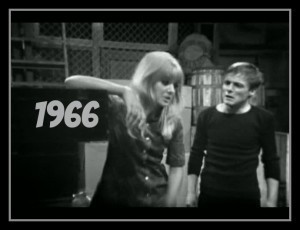 As a child I discovered Doctor Who in bits and pieces, fragments of borrowed VHS tapes, Target novels and TV repeats. While Tom Baker was most often on our screens, a great deal of my fascination of the show came from its complex history, and I fell hard for the early black and white stories despite (or because of) how much harder it was to access them.
As a child I discovered Doctor Who in bits and pieces, fragments of borrowed VHS tapes, Target novels and TV repeats. While Tom Baker was most often on our screens, a great deal of my fascination of the show came from its complex history, and I fell hard for the early black and white stories despite (or because of) how much harder it was to access them.
A lot of my early relationships with the characters involved mad shipping, but the fandom I had access to didn’t seem to view it in those terms – or didn’t talk about it like that in front of me, as I was only a kid! I knew my Mum fancied Tom Baker, but that was about it. Immersed in modern fandom ideas as I now am, it becomes obvious that I have firm, unbending views on the relationships in the show, developed all in my own independent bubble.
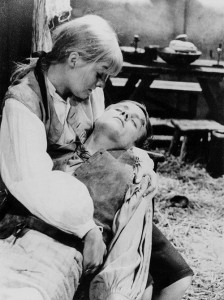 I only have a handful of Classic Who ships, and they are pretty unadventurous ones. It never occurred to me to speculate on the Doctor’s love life at all, even in the days of Romana (though come ON), and the only ship of the 1970-1989 era that held any appeal to my younger self at all was Turlough-and-everybody-except-Tegan. These days I’m more interested in shipping Jack Harkness with EVERYONE IN THE 1970′s, but we’re not talking about current me here!
I only have a handful of Classic Who ships, and they are pretty unadventurous ones. It never occurred to me to speculate on the Doctor’s love life at all, even in the days of Romana (though come ON), and the only ship of the 1970-1989 era that held any appeal to my younger self at all was Turlough-and-everybody-except-Tegan. These days I’m more interested in shipping Jack Harkness with EVERYONE IN THE 1970′s, but we’re not talking about current me here!
The black and white era is a hotbed of romance! When it comes to Ian and Barbara, Ben and Polly, Jamie and Victoria, I am sold forever. Barbara and Ian is practically canon and always was – and thanks to Russell T Davies and the Sarah Jane Adventures, we have official confirmation of what all fans pretty much always knew, that they got married soon after returning to 1965 and lived happily ever after. Jamie and Victoria is slightly more a product of my romantic imagination and several soppy publicity pictures of the two actors while filming The Abominable Snowmen, and I have to admit to being a lot less invested in them these days under the weight of the gorgeously crafted Two/Jamie ship that a small but fervent percentage of the internet are so very convincing about. (The internet has also introduced me to the joys of the Brigadier/Three ship, which changed the way I view Doctor Who forever)
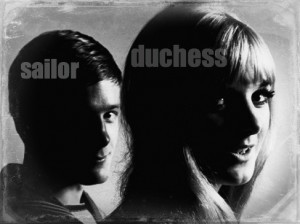 But Ben and Polly are my favourites and my best. They’re the only ones I ever wrote fanfic about in my teens to ensure they got together (again, before I knew fanfic was a thing, oh internet where WERE you). Possibly this happened because of my shock discovery that there were fans out there in the world who thought MAYBE BEN AND POLLY DIDN’T GET TOGETHER. I seem to recall one of the Short Trips anthologies making it clear that there was no permanent relationship between the two of them, and I don’t believe anything else happened in my teen years which caused more of a sense of inner outrage. YES REALLY.
But Ben and Polly are my favourites and my best. They’re the only ones I ever wrote fanfic about in my teens to ensure they got together (again, before I knew fanfic was a thing, oh internet where WERE you). Possibly this happened because of my shock discovery that there were fans out there in the world who thought MAYBE BEN AND POLLY DIDN’T GET TOGETHER. I seem to recall one of the Short Trips anthologies making it clear that there was no permanent relationship between the two of them, and I don’t believe anything else happened in my teen years which caused more of a sense of inner outrage. YES REALLY.
Luckily Big Finish felt the same way I did, and recently made it canon of their own in the Christmas special “The Four Companions” which reunited Polly with the Fifth Doctor. When he asked if she ever sees anything of Ben, she replied archly: “I see all of him, every day,” and then challenged him for not shipping them all along because of class issues. I danced, reader. I danced. As if it was ever going to be anything else for those two.
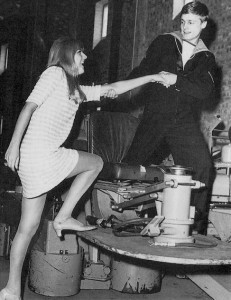 The sailor and the “duchess,” a rough-speaking Cockney lad and a posh blonde secretary, running around time and space with the Doctor. I loved these two insanely, despite the fact that I had only seen them in a few fragmented episodes from The Moon Base and a tiny bit of Tenth Planet. Later – much later, actually, I secured the VHS tape of The War Machines, the only story which exists in its entirety, and fell in love all over again, delighted at Polly’s sparky wit and Ben’s general competence and loyalty.
The sailor and the “duchess,” a rough-speaking Cockney lad and a posh blonde secretary, running around time and space with the Doctor. I loved these two insanely, despite the fact that I had only seen them in a few fragmented episodes from The Moon Base and a tiny bit of Tenth Planet. Later – much later, actually, I secured the VHS tape of The War Machines, the only story which exists in its entirety, and fell in love all over again, delighted at Polly’s sparky wit and Ben’s general competence and loyalty.
The War Machines is a strange, compelling piece of Doctor Who history. For the first three years of the show, An Unearthly Child remained an anomaly, with only a few other brief stops anywhere near what you might call ‘contemporary Earth’ – Barbara, Ian and Susan visited modern Earth in Planet of the Giants, but were distracted by having been miniaturised. There were a couple of brief pit stops in The Chase, but none of them were a focus of the story, and only right at the end was it clearly the ‘current’ time rather than the past or the future. There was the Christmas episode in the middle of The Daleks’ Master Plan, but only a tiny piece of it was set in a modern police station, the rest being taken up by a romp through early Hollywood. Even Dodo, herself a contemporary English companion, was picked up in a fleeting ‘last five minutes of the story’ visit to the 1960’s.
 The War Machines, though, is thoroughly contemporary. It’s 1966 and then some. In many ways, it serves as the model for the modern ‘introducing the companion’ story. Only a few stories away from the end of the Hartnell era, it launched a new tradition which would quickly eclipse the historical stories. Not until the late 80’s (the gap between the Two Doctors in March 1985 and Silver Nemesis in late 1988) would the Doctor go even a whole season let alone three without having at least one story substantially set on ‘contemporary Earth’ or a near-future so close as to be almost indistinguishable from it.
The War Machines, though, is thoroughly contemporary. It’s 1966 and then some. In many ways, it serves as the model for the modern ‘introducing the companion’ story. Only a few stories away from the end of the Hartnell era, it launched a new tradition which would quickly eclipse the historical stories. Not until the late 80’s (the gap between the Two Doctors in March 1985 and Silver Nemesis in late 1988) would the Doctor go even a whole season let alone three without having at least one story substantially set on ‘contemporary Earth’ or a near-future so close as to be almost indistinguishable from it.
In fact the three Ben and Polly stories with the First Doctor reflect the formula now so familiar to New Who viewers: contemporary with SF monsters/problems, historical, and futuristic/space.
How contemporary is The War Machines? Well, there’s the Doctor going into a nightclub, there’s flirting, there’s a computer that goes crazy, and most of all there’s the streets of London, beautifully shot on location and serving as host to a robot invasion. There’s also a strange fixation upon the Post Office Tower, possibly best known to Australians as that one that got knocked over by the giant kitten in the Goodies.
Most of all, we have Ben and Polly being adorable, solving mysteries and teasing each other, having so much fun that you quite forget that poor old Dodo has been written out mid-story. The new TARDIS team is here, and they are groovy.
I will go down with this ship.
ELSEWHERE ON 1966:
Anneke Wills (Polly) on achieving cultural immortality [Radio Times]
Kingdom and Katarina – the Women of the Dalek’s Master Plan [tansyrr.com]
The Gunfighters [Hoo on Who]
Blood Upon the Sawdust [Radio Free Skaro]
The War Machines [Wife in Space]
The Smugglers [The Memory Cheats]
The Tenth Planet [Wife in Space]
The Tenth Planet [Calapine]
A Modern Woman’s Guide to Classic Who – The Second Doctor Years [tansyrr.com]
The Power of the Daleks [Wife in Space]

